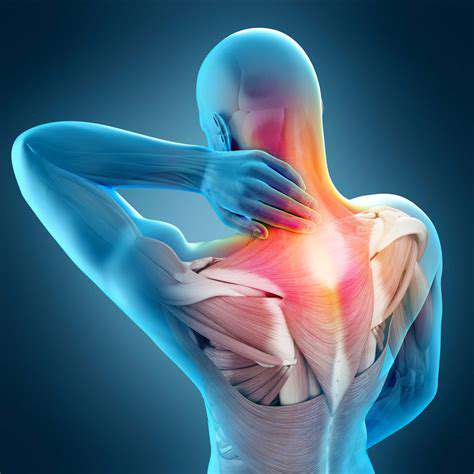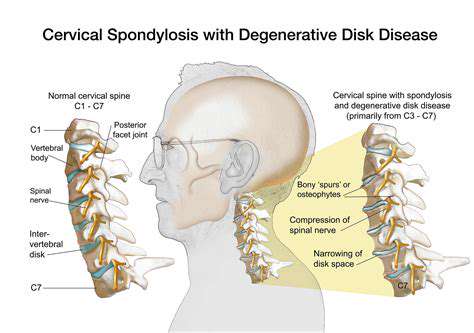Muscle Strain and Tension

Understanding Muscle Strain
Muscle strain occurs when the muscle fibers are overstretched or torn, often resulting from excessive physical activity or improper lifting techniques. It can lead to pain, stiffness, and inflammation in the affected area.
Common activities that can lead to muscle strain include heavy lifting, sudden movements, or even maintaining poor posture for extended periods. Identifying the strain early on is crucial to prevent further damage and to facilitate recovery.
Identifying Tension in the Neck and Shoulders
Tension in the neck and shoulder muscles often results from stress, poor ergonomics, or prolonged periods of inactivity. This tension can radiate to the back of the head, creating discomfort that can be both persistent and debilitating.
Regularly assessing your posture and taking breaks during long periods of sitting can help reduce the buildup of tension. Engaging in relaxation techniques such as deep breathing or gentle stretching can also alleviate some of the discomfort associated with neck and shoulder tension.
Effective Remedies for Relief
To relieve Muscle Strain and Tension, several remedies are available that can aid in recovery. Resting the affected muscle is vital, along with applying ice or heat to reduce inflammation and promote blood flow.
Additionally, over-the-counter pain relievers can provide temporary relief from pain. Incorporating gentle stretching and strengthening exercises can also play a significant role in preventing future injuries.
Migraine and Tension Headaches
Migraine Headaches
Migraine headaches are often severe and can be characterized by throbbing pain, usually on one side of the head. They may also be accompanied by other symptoms such as nausea, vomiting, and sensitivity to light and sound.
Individuals suffering from migraines often report a warning phase, known as an aura, which may involve visual disturbances or tingling sensations. These auras can vary in duration and intensity.
Triggers for migraines can include stress, hormonal changes, certain foods, and environmental factors. Keeping a headache diary can help identify personal triggers, enabling better management of the condition.
Treatment options for migraines typically involve medications, both preventive and abortive. Over-the-counter pain relievers may work for some, but prescription medications are often necessary for more severe cases.
Alternative remedies, such as relaxation techniques, acupuncture, and dietary changes, may also provide relief for migraine sufferers. Staying hydrated and maintaining a consistent sleep schedule are vital for managing migraine episodes.
Tension Headaches
Tension headaches are the most common type of headache and often present as a dull, aching sensation all around the head. They may feel like tightness or pressure, with discomfort extending to the neck and shoulders.
These headaches often result from stress, muscle tension, or postural issues. Factors such as anxiety and poor ergonomic practices can exacerbate the severity and frequency of tension headaches.
Unlike migraines, tension-type headaches tend to occur bilaterally and usually do not include nausea or vomiting. However, they can still significantly impact daily life and productivity.
Managing tension headaches often involves stress management techniques, such as mindfulness, deep breathing exercises, and regular physical activity. Incorporating regular breaks during work can also relieve muscle tension.
Over-the-counter analgesics, such as acetaminophen and ibuprofen, can be effective in alleviating pain caused by tension headaches. Maintaining good hydration and practicing good sleep hygiene can further aid in prevention.
Preventive Measures and Lifestyle Changes
Coping with migraines and tension headaches often requires a multifaceted approach that includes both treatment and preventive strategies. Maintaining a healthy lifestyle is crucial in this respect.
Regular physical exercise not only helps reduce stress but also contributes to overall health, potentially decreasing the frequency and intensity of headaches. Activities like yoga, stretching, or walking can be particularly beneficial.
Establishing a consistent sleep routine is equally important; both inadequate sleep and excessive sleep can trigger headaches. Aim for a regular sleep schedule, ensuring that you get enough restorative sleep each night.
Dietary habits play a significant role in headache management. Identifying and avoiding trigger foods, such as those high in caffeine or aged cheeses, can significantly help in preventing headache episodes.
Lastly, effective stress management techniques, including practice mindfulness, may help reduce the prevalence of migraines and tension headaches. Incorporating relaxation strategies into your daily routine can lead to longer-lasting relief and improved overall well-being.
Cervical Spine Disorders

Cervical Spondylosis
Cervical spondylosis is a degenerative condition of the cervical spine, often related to aging. This disorder can lead to Chronic pain, stiffness, and decreased mobility in the neck area. It occurs due to the wear and tear of the vertebral discs and joints, resulting in bone spurs and reduced disc height.
Symptoms may vary, with some individuals experiencing no noticeable signs while others suffer from acute pain radiating to the shoulders and back. Early diagnosis and treatment are crucial in managing symptoms and improving quality of life. Physical therapy, medications, and lifestyle changes can all contribute to effective management.
In severe cases, surgical intervention may be necessary to relieve pressure on the spinal cord or nerves. It's important to consult a healthcare professional for personalized advice and treatment options specific to your condition.
Herniated Discs
A herniated disc in the cervical spine can cause significant discomfort, including pain in the back of the head and neck. This occurs when the soft inner gel of the disc bulges out through a tear in the outer layer, potentially compressing nearby nerves. The resultant pain can radiate down the arms and affect overall mobility.
Common treatments include physical therapy, pain management with medications, and lifestyle modifications. In many cases, conservative treatments are effective, but if pain persists, surgical options may be considered. It's essential to maintain a healthy weight and practice good posture to reduce the risk of disc herniation.
Recognizing symptoms early can facilitate timely treatment and prevent further complications. Always consult with a physician before starting any treatment plan to ensure it aligns with your health needs.
Muscle Strain and Tension
Muscle strain and tension in the neck can arise from poor posture, repetitive motions, or overexertion. These issues may lead to muscle stiffness, headaches, and discomfort in the back of the head. Factors like stress and sleeping in awkward positions can also contribute to muscle tension in these areas.
Management often involves rest, heat therapy, and gentle stretching exercises to relieve tension. In more severe cases, over-the-counter pain relievers may be recommended to manage discomfort. Practicing good posture and regularly engaging in neck-strengthening exercises can help prevent future muscle strain.
Additionally, integrating relaxation techniques such as yoga or mindfulness can be beneficial in alleviating tension. Consulting a healthcare provider can provide tailored recommendations for muscle strain management.
Whiplash Injuries
Whiplash is a common neck injury that occurs due to sudden movement of the head, often during car accidents. Symptoms may not be immediately apparent and can develop over days, including neck pain, stiffness, and headaches. Prompt treatment is essential to facilitate recovery and prevent chronic issues.
Diagnosis usually involves a thorough physical examination and may include imaging tests to assess damage to the cervical spine. Treatment options can range from rest and ice to physical therapy and medications for pain relief. Developing a personalized rehabilitation plan is critical for effective healing.
Preventive measures include wearing seatbelts and adjusting headrests appropriately in automobiles. Awareness of whiplash symptoms enables individuals to seek timely medical attention, which is vital for recovery.
Cervical Radiculopathy
Cervical radiculopathy occurs when a nerve in the neck becomes pinched, often causing pain that radiates down the arm. This condition can stem from various issues, including herniated discs, bone spurs, or degenerative changes in the spine. Identifying the underlying cause is key to effective treatment.
Treatment typically includes a combination of pain management techniques, such as physical therapy, medications, or spinal injections. In some cases, surgical options may be necessary to relieve nerve compression. Early intervention can significantly improve outcomes and prevent further complications.
Those suffering from symptoms should seek medical advice to explore their options and determine the most suitable approach for their situation. Keeping a healthy lifestyle and managing risk factors can play a crucial role in maintaining spinal health.
Medical Conditions
Muscle Strain and Tension
One of the most common reasons for discomfort in the back of the head and neck is muscle strain. This can occur from various activities, including poor posture, prolonged sitting, or even sleeping in an awkward position.
When the muscles in the neck and upper back become tense, they can put pressure on nerves, leading to pain that may be felt in the back of the head.
Regular stretching and strengthening exercises can help alleviate muscle tension. Yoga and physical therapy are also effective options for reducing strain and improving posture.
In cases where muscle strain is persistent, it may be beneficial to consult a medical professional for tailored advice and treatment options.
Migraines and Headaches
Migraines and other headache disorders can lead to pain that radiates to the back of the head and neck. These types of headaches can be triggered by various factors, including stress, dietary choices, and changes in sleep patterns.
The pain associated with migraines may come with other symptoms like nausea, sensitivity to light, and aura. Identifying triggers is key to managing these headaches effectively.
Over-the-counter medications and prescribed treatments can provide relief for migraine sufferers. Keeping a headache diary may help in recognizing patterns and triggers.
For chronic migraines, preventive strategies, such as lifestyle changes or medication, may be necessary to improve quality of life and reduce frequency.
Cervical Spondylosis
Cervical spondylosis, commonly known as neck arthritis, is a degenerative condition that affects the cervical spine, leading to stiffness and pain in the neck and back of the head.
This condition often develops due to the natural aging process, and factors like previous injuries or repetitive strains can exacerbate it. Symptoms may include neck pain, headaches, and limited neck mobility.
Treatment options often involve a multimodal approach, including medications for pain relief, physical therapy, and, in severe cases, surgical intervention.
Maintaining an active lifestyle and engaging in regular neck-strengthening exercises can help slow the progression of cervical spondylosis and alleviate symptoms.
Nerve Compression
Nerve compression in the cervical spine often results from conditions such as herniated discs or bone spurs, leading to pain that radiates to the back of the head and neck.
This compression can cause symptoms like tingling, numbness, or weakness in addition to pain. It is crucial to address these issues as they can worsen over time if left untreated.
Diagnosis typically involves physical exams and imaging studies to determine the cause and extent of nerve compression. Treatment may include physical therapy, pain management with medications, or surgical options.
Considerations for prevention include maintaining good posture and engaging in regular exercise to strengthen the neck muscles and improve spinal alignment.
Stress and Mental Health
Stress and anxiety are significant factors that can lead to chronic pain in the back of the head and neck. When individuals are under stress, they often unconsciously tense their neck and shoulder muscles, which can lead to discomfort.
Furthermore, chronic stress can exacerbate pre-existing medical conditions, making it crucial to address mental health as part of a comprehensive pain management plan.
Relaxation techniques such as mindfulness, meditation, and deep breathing can be beneficial in reducing stress levels and alleviating physical tension.
If mental health issues significantly impact daily life, speaking with a mental health professional can provide support and strategies for coping with stress and its physical manifestations.